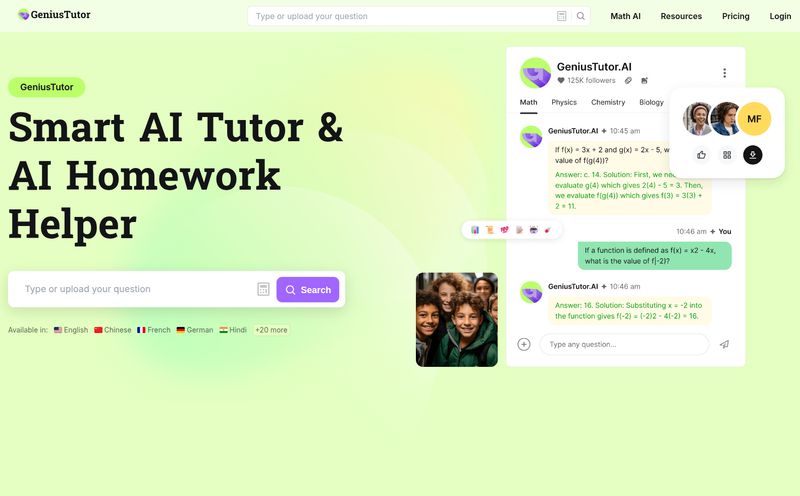Alright, let’s have a real chat. For years, I’ve been on the language learning rollercoaster. I’ve downloaded the apps. I’ve bought the dusty textbooks. I can probably order a coffee in about seven languages, but can I talk about the weather, my day, or why pineapple on pizza is a crime against humanity? That’s… a different story.
The gap between knowing words and actually speaking a language is a canyon. It's a place many of us get stuck, a frustrating plateau where you can read and listen but your tongue feels like it’s tied in knots when you try to speak. It’s the digital age, so naturally, AI has waltzed in, promising to be the bridge over that canyon. One of the most interesting contenders I've seen lately is a platform called Think in Italian. It's not just another flashcard app. It claims to be your personal AI tutor, laser-focused on one thing: getting you to speak Italian fluently and confidently.
So, is it just clever marketing, or is this the real deal? I decided to pull back the curtain and see for myself.
So, What is Think in Italian, Really?
First off, this isn't your typical gamified, cartoon-owl-led experience. Think in Italian was created by an actual Italian linguist, and you can feel that academic backbone. The core idea is to move you away from translating in your head and get you to, well, think in Italian. Groundbreaking, I know.
It's built around an AI-powered conversational tool. Think of it less like a teacher with a red pen and more like a super-patient, endlessly available Italian friend who gently corrects your mistakes in real-time. The entire ecosystem is designed to be a stress-free immersion environment. You practice real-life conversations, get instant feedback on your grammar and pronunciation, and move at a pace that is entirely your own. It's a personal trainer for your tongue.

Visit Think in Italian
My First Impressions and Getting Started
Jumping in is pretty straightforward. The website is clean, and the promise is clear: “Achieve Fluency in 3 simple steps.” Bold claim. I like the confidence. The sign-up process leads you toward a 7-day free trial, which is always a good sign in my book. It shows the creators believe you'll stick around once you see what's inside.
The dashboard isn’t cluttered with a million buttons or distracting animations. It feels purposeful. You’re there to learn, and the platform respects that. It funnels you right into the learning material, which is a mix of audio lessons, readings, and of course, the AI tutor. It feels less like a game and more like a serious toolkit for a dedicated student.
The Core Features That Actually Matter
A platform is only as good as its tools. Here’s a breakdown of what makes Think in Italian tick.
The AI Conversation Partner
This is the main event. The AI tutor is where the magic is supposed to happen. You speak into your microphone, and it responds. But the real kicker is the instant feedback. If you botch a verb conjugation or mispronounce a word, it doesn’t just let it slide. It points it out, explains the correction, and lets you try again. I’ve mumbled my way through a few ciao, come stai? exchanges in my time, and I have to say, the speech recognition is surprisingly accurate. It's caught some of my more… creative pronunciations, which is both humbling and incredibly useful.
A Curriculum That Bends To You
We’ve all been through learning programs that feel rigid and impersonal. Think in Italian uses an adaptive curriculum. It gauges your level and adjusts the difficulty of conversations and lessons accordingly. You’re not stuck learning colors and fruits for weeks if you’re already past that. This personalized approach is a huge win for keeping motivation high. It feels like the system is working for you, not just dragging you along a pre-set path.
Beyond the Chatbot: A Library of Resources
I was pleasantly surprised to find that this wasn't a one-trick pony. Alongside the AI chat, there’s a whole library of supporting materials. You get audio lessons you can listen to on the go, readings with bilingual transcripts (a lifesaver for context), and some pretty solid Italian grammar guides. It’s a comprehensive package. This approach makes sure you're not just learning to mimic phrases but actually understanding the structure of the language, the why behind the words.
What's the Damage? A Look at Think in Italian's Pricing
Okay, let's talk turkey. This isn’t a free-to-play app with ads everywhere. It’s a premium product, and it has a premium price tag. Here’s the breakdown I found on their site:
| Plan Type | Billing Cycle | Effective Cost | Total Billed |
|---|---|---|---|
| Monthly Plan | Billed Monthly | $49 / month | $49 |
| Yearly Plan (Best Value) | Billed Annually | $29 / month | $348 |
| Lifetime Plan | One-Time Payment | - | $499 |
My take? The monthly plan is steep, best for someone who wants to try it intensely for a month or two. The yearly plan offers significant savings and is a better option for anyone serious about their goals. But that Lifetime plan... that's the interesting one. For the cost of about 10 months on the monthly plan, you get access forever. If you are genuinely committed to mastering Italian, that one-time payment is pretty compelling. Plus, with a 30-day guarantee, the risk is fairly low.
The Good, The Bad, and The "It Depends"
What I Genuinely Love
The instant, private feedback is a game-changer. There's zero embarrassment factor. You can butcher the word 'gli' a hundred times and the AI won’t judge you. It will just keep correcting you. This builds confidence in a way that practicing with a human (and the fear of looking silly) sometimes can't. The focus on real-world conversation from the get-go is also fantastic. You're learning things you would actually say, not just random vocabulary lists.
Where It Might Fall Short
Let's be real, the price will be a hurdle for some. It's an investment. Also, as great as AI is, it lacks the spontaneity and cultural nuance of a real human. It can’t tell you a funny story about its nonna or go off on a tangent about a local festival. Some learners thrive on that human connection, and for them, this might feel a little too sterile. It's a brilliant tool, but it's not a replacement for human interaction, rather a powerful supplement to it.
Who is Think in Italian Actually For?
I see this being perfect for a few types of people:
- The Dedicated Beginner: Someone starting from scratch who wants to build a strong speaking foundation and avoid the common pitfalls of just learning theory.
- The Intermediate Platonist: This is the person who feels stuck. You understand a lot, but you can’t speak smoothly. This tool is practically designed to break you through that barrier.
- The Busy Professional: Someone who needs to learn Italian for work or relocation but doesn’t have time for fixed-schedule classes. The 24/7 availability of an AI tutor is a massive advantage.
It's probably not for the casual learner who just wants a few phrases for a one-week vacation in Rome. There are cheaper, simpler apps for that.
Conclusion: Is It Worth Your Time and Money?
After spending some quality time with the platform, I'm genuinely impressed. Think in Italian isn't just another language app; it's a highly focused training system. It tackles the single biggest challenge for most language learners—the fear and difficulty of actually speaking—head-on.
Is it a magic pill for fluency? Of course not. You still have to put in the work, you still have to show up and practice. But it provides a structured, supportive, and incredibly effective environment to do that work. If you are serious about speaking Italian and are tired of feeling stuck, I think the investment is absolutely worth considering. It could very well be the tool that finally gets your tongue untied.
Frequently Asked Questions (FAQ)
- How is Think in Italian different from apps like Duolingo?
- The main difference is the focus. While Duolingo is great for building vocabulary and basic sentence structure in a gamified way, Think in Italian is specifically designed for conversational fluency. It uses an AI tutor to simulate real conversations and provide instant, detailed feedback on your speech, which is its core strength.
- Do I need to know any Italian before I start?
- Not at all. The platform is built with an adaptive curriculum that can cater to absolute beginners as well as intermediate learners. It will assess your level and tailor the content to you.
- Is there a free trial?
- Yes, Think in Italian offers a 7-day free trial, allowing you to explore the platform's features before committing to a paid plan. They also have a 30-day money-back guarantee.
- Can this AI tutor really replace a human teacher?
- It's more of a powerful supplement than a direct replacement. The AI offers incredible patience, 24/7 availability, and instant correction without judgment. However, a human tutor can provide cultural insights, spontaneity, and personal connection that an AI can't. For best results, it could be used alongside occasional practice with a native speaker.
- What's included in the Lifetime plan?
- The Lifetime plan gives you one-time, permanent access to all of Think in Italian's content. This includes all current and future courses, the AI tutor, audio lessons, readings, grammar resources, and any other updates to the platform.
- How accurate is the speech recognition?
- In my experience, its pretty darn good. It's sensitive enough to catch common pronunciation errors that other apps might miss, which is crucial for developing an authentic accent. Like any tech, it's not 100% flawless, but it's more than effective for its purpose.



